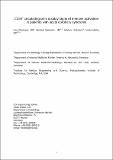| dc.contributor.author | Riesinger, Lisa | |
| dc.contributor.author | Saemisch, Michael | |
| dc.contributor.author | Nickmann, Markus | |
| dc.contributor.author | Methe, Heiko | |
| dc.date.accessioned | 2021-09-20T17:16:55Z | |
| dc.date.available | 2021-09-20T17:16:55Z | |
| dc.date.issued | 2018-07-12 | |
| dc.identifier.uri | https://hdl.handle.net/1721.1/131400 | |
| dc.description.abstract | Abstract
Bone marrow-derived endothelial progenitor cells (EPC) are released into the peripheral blood in situations of vascular repair/angiogenesis. Regulation of vascular repair and angiogenesis by EPC depends not only on the number of circulating EPC but also on their functionality. As endothelial cells can act as antigen-presenting cells in coronary artery disease (CAD), we postulated that EPC can be immune activated here as well. CD34+-EPC were isolated from peripheral blood of patients with ST-elevation myocardial infarction (STEMI, n = 12), non-STEMI/unstable angina (UA, n = 15), and stable CAD (SA, n = 18). Expression of HLA-DR, adhesion and costimulatory molecules by isolated CD34+-EPC were compared with levels in healthy controls (n = 18). There were no significant differences in VCAM-1 and CD80 expression by peripheral circulating CD34+-EPC between the four groups, yet expression of CD86 was highest in UA (p < 0.05). ICAM-1 expression was lowest in SA (p < 0.01). CD34+-EPC constitutively expressed HLA-DR across all groups. Of note, patients pretreated with HMG-CoA reductase inhibitors exhibited lower expression of VCAM-1 by CD34+-EPC throughout all patient groups; furthermore, statins significantly limited ex vivo-induced upregulation of ICAM-1 by TNF-alpha. To the best of our knowledge, this is the first study to examine the expression of immune markers in peripheral circulating CD34+-EPC ex vivo. We demonstrate that CD34+-EPC display different patterns of adhesion and costimulatory molecules in various states of CAD. Expression levels were affected by pretreatment with statins. Hence, immune activity of peripheral circulating CD34+ cells might play a pathophysiologic role in evolution of CAD. | en_US |
| dc.publisher | Springer Japan | en_US |
| dc.relation.isversionof | https://doi.org/10.1007/s00380-018-1220-7 | en_US |
| dc.rights | Article is made available in accordance with the publisher's policy and may be subject to US copyright law. Please refer to the publisher's site for terms of use. | en_US |
| dc.source | Springer Japan | en_US |
| dc.title | CD34+ circulating cells display signs of immune activation in patients with acute coronary syndrome | en_US |
| dc.type | Article | en_US |
| dc.contributor.department | Massachusetts Institute of Technology. Institute for Medical Engineering & Science | |
| dc.eprint.version | Author's final manuscript | en_US |
| dc.type.uri | http://purl.org/eprint/type/JournalArticle | en_US |
| eprint.status | http://purl.org/eprint/status/PeerReviewed | en_US |
| dc.date.updated | 2020-09-24T20:44:08Z | |
| dc.language.rfc3066 | en | |
| dc.rights.holder | Springer Japan KK, part of Springer Nature | |
| dspace.embargo.terms | Y | |
| dspace.date.submission | 2020-09-24T20:44:08Z | |
| mit.license | PUBLISHER_POLICY | |
| mit.metadata.status | Authority Work and Publication Information Needed | |
